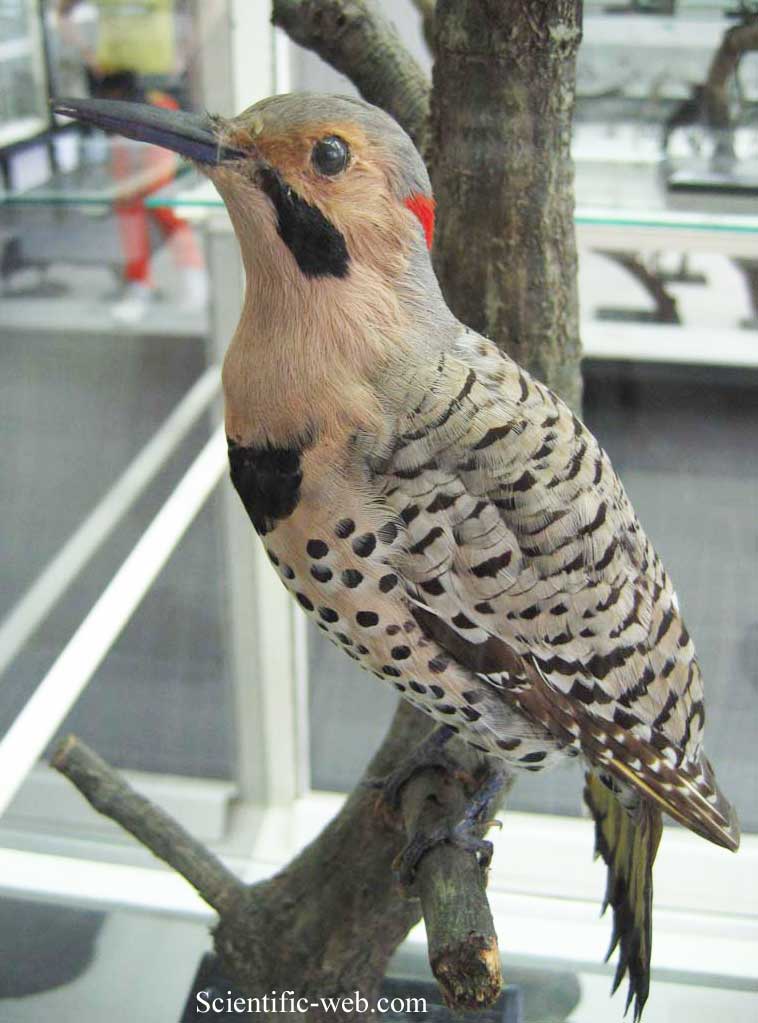
Colaptes auratus, Photo: Michael Lahanas
Superregnum: Eukaryota
Cladus: Unikonta
Cladus: Opisthokonta
Cladus: Holozoa
Regnum: Animalia
Subregnum: Eumetazoa
Cladus: Bilateria
Cladus: Nephrozoa
Superphylum: Deuterostomia
Phylum: Chordata
Subphylum: Vertebrata
Infraphylum: Gnathostomata
Megaclassis: Osteichthyes
Cladus: Sarcopterygii
Cladus: Rhipidistia
Cladus: Tetrapodomorpha
Cladus: Eotetrapodiformes
Cladus: Elpistostegalia
Superclassis: Tetrapoda
Cladus: Reptiliomorpha
Cladus: Amniota
Classis: Reptilia
Cladus: Eureptilia
Cladus: Romeriida
Subclassis: Diapsida
Cladus: Sauria
Infraclassis: Archosauromorpha
Cladus: Crurotarsi
Divisio: Archosauria
Cladus: Avemetatarsalia
Cladus: Ornithodira
Subtaxon: Dinosauromorpha
Cladus: Dinosauriformes
Cladus: Dracohors
Cladus: Dinosauria
Ordo: Saurischia
Cladus: Eusaurischia
Subordo: Theropoda
Cladus: Neotheropoda
Cladus: Averostra
Cladus: Tetanurae
Cladus: Avetheropoda
Cladus: Coelurosauria
Cladus: Tyrannoraptora
Cladus: Maniraptoromorpha
Cladus: Maniraptoriformes
Cladus: Maniraptora
Cladus: Pennaraptora
Cladus: Paraves
Cladus: Eumaniraptora
Cladus: Avialae
Infraclassis: Aves
Cladus: Euavialae
Cladus: Avebrevicauda
Cladus: Pygostylia
Cladus: Ornithothoraces
Cladus: Ornithuromorpha
Cladus: Carinatae
Parvclassis: Neornithes
Cohors: Neognathae
Cladus: Neoaves
Ordo: Piciformes
Familia: Picidae
Subfamilia: Picinae
Genus: Colaptes
Species: Colaptes auratus
Subspecies C. a. auratus – C. a. cafer – C. a. chrysocaulosus – C. a. collaris – C. a. gundlachi – C. a. luteus – C. a. mexicanoides – C. a. mexicanus – C. a. nanus
Subspecies extinctae: † C. a. rufipileus
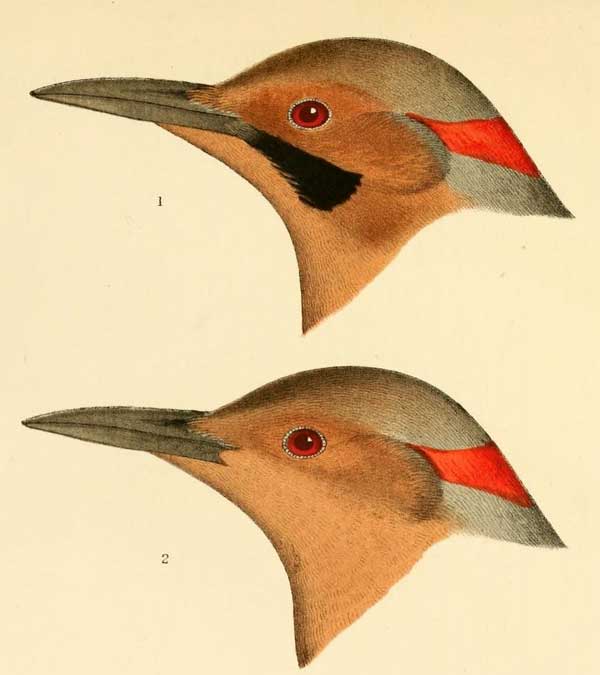
Colaptes auratus
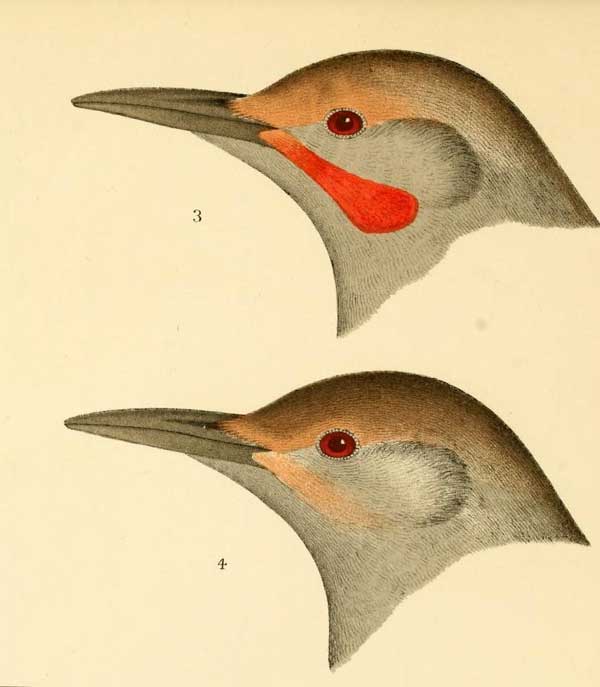
Colaptes auratus mexicanus
Name
Colaptes auratus (Linnaeus, 1758)
Synonyms
Cuculus auratus (protonym)
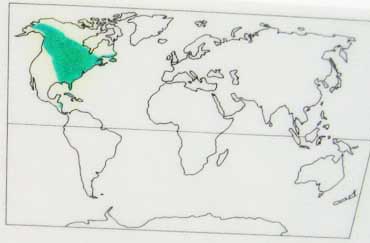
References
Linnaeus, C. 1758. Systema Naturae per regna tria naturae, secundum classes, ordines, genera, species, cum characteribus, differentiis, synonymis, locis. Editio Decima, Reformata. Tomus I. Holmiæ (Stockholm): impensis direct. Laurentii Salvii. 824 pp. DOI: 10.5962/bhl.title.542 BHL p. 112 BHL Reference page.
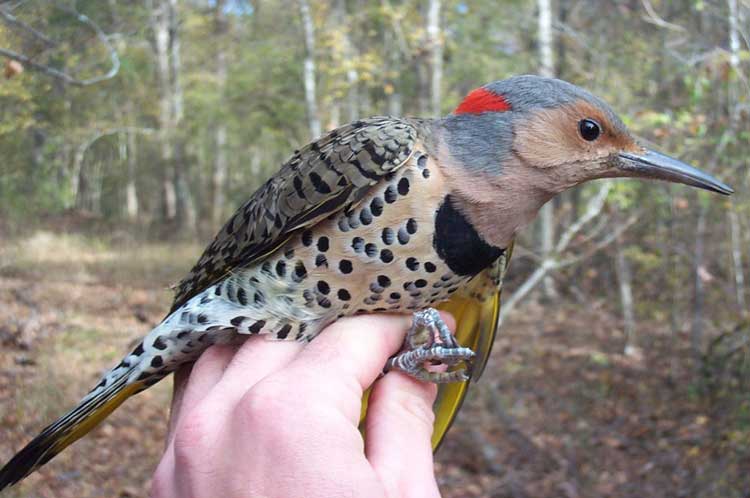
Colaptes auratus
Vernacular names
български: Златист шилоклюн кълвач
català: Picot escapulat oriental
ᏣᎳᎩ: ᎤᎵᎦᏓ
čeština: Datel zlatý
Cymraeg: Ysgytiwr gogleddol
dansk: Guldspætte
Deutsch: Goldspecht
English: Northern Flicker
Esperanto: Ora pego
español: Carpintero escapulario
فارسی: دارکوب طلایی شمالی
suomi: Kultatikka
français: Pic flamboyant
magyar: Aranyküllő
íslenska: Gullklambra
italiano: Picchio dorato
日本語: ハシボソキツツキ
Nederlands: Gouden Grondspecht
norsk: Gullspett
Diné bizaad: Tʼáyaałchííʼ
occitan: Pic flamejant
polski: Dzięcioł różowoszyi
پنجابی: کولیپٹس اوراٹس
português: Pica-pau-mosqueado
Runa Simi: Chinchay Awya Yala akakllu
русский: Золотой шилоклювый дятел
slovenčina: Vlikáč zlatý
svenska: Guldspett
удмурт: Зарни сизь
українська: Декол золотистий
中文: 北扑翅鴷
The northern flicker (Colaptes auratus) or common flicker is a medium-sized bird of the woodpecker family. It is native to most of North America, parts of Central America, Cuba, and the Cayman Islands, and is one of the few woodpecker species that migrate. Over 100 common names for the northern flicker are known, including yellowhammer (not to be confused with the Eurasian yellowhammer), clape, gaffer woodpecker, harry-wicket[citation needed], heigh-ho, wake-up, walk-up, wick-up, yarrup, and gawker bird. Many of these names derive from attempts to imitate some of its calls. It is the state bird of Alabama (known by its colloquial name "Yellowhammer.")[2]
Taxonomy
The English naturalist Mark Catesby described and illustrated the northern flicker in his book The Natural History of Carolina, Florida and the Bahama Islands which was published between 1729 and 1732. Catesby used the English name "Gold-winged Wood-pecker" and the Latin Picus major alis aureis.[3] When in 1758 the Swedish naturalist Carl Linnaeus updated his Systema Naturae for the tenth edition, he included the northern flicker, coined the binomial name Cuculus auratus and cited Catesby's book.[4] The specific epithet auratus is a Latin word meaning "gilded" or "ornamented with gold".[5] The type locality is South Carolina.[6] The northern flicker is one of 13 extant New World woodpeckers now placed in the genus Colaptes that was introduced by the Irish zoologist Nicholas Aylward Vigors in 1825 with the northern flicker (Colaptes auratus) as the type species.[7]
Ten subspecies of northern flicker are recognized, of which one is now extinct.[8] The extant subspecies were at one time considered subspecies of two separate species called the yellow-shafted flicker (C. auratus) and the red-shafted flicker (C. cafer), but they commonly interbreed where their ranges overlap and are now considered one species by the American Ornithologists Union. This is an example of what is referred to as the "species problem".
The southern yellow-shafted flicker (C. a. auratus) resides in the southeastern United States. They are yellow under the tail and underwings and have yellow shafts on their primaries. They have a grey cap, a beige face, and a red bar at the nape of the neck. Males have a black mustache. Colaptes comes from the Greek verb colapt, meaning "to peck"; auratus is from the Latin root aurat, meaning "gold" or "golden", and refers to the bird's underwings. As the state bird of Alabama,[9] this subspecies is known by the common name "yellowhammer", a term that originated during the American Civil War to describe Confederate soldiers from Alabama.[10]
The northern yellow-shafted flicker (C. a. luteus; syn. C. a borealis) resides from central Alaska through most of Canada to southern Labrador, Newfoundland, and the northeastern United States.
The Cuban yellow-shafted flicker (C a. chrysocaulosus) is restricted to Cuba.
The Grand Cayman yellow-shafted flicker (C. a. gundlachi) is restricted to Grand Cayman in the Cayman Islands.
The western red-shafted flicker (C. a. cafer) resides in western North America. It is red under the tail and underwings and have red shafts on their primaries. It has a beige cap and a grey face. Males have a red mustache. The subspecific name cafer is the result of an error made in 1788 by the German systematist Johann Gmelin, who believed that its original habitat was in South Africa among the Xhosa people, then known as the "Kaffirs". As the origin of the subspecies designation is regarded as offensive by some, proposals to alter the scientific name of this subspecies have been presented to the American Ornithological Society. The Society, in accordance with the rules governing scientific nomenclature, has as of September 2018 declined to support a change of the scientific name, but may consult with the ICZN on the matter.[11][12]
The coastal red-shafted flicker (C. a. collaris) has a range that closely overlaps that of C. a. cafer, extending along much of the West Coast of North America from British Columbia to northwestern Mexico.
The dwarf red-shafted flicker (C. a. nanus) resides in western Texas south to northeastern Mexico.
The Mexican red-shafted flicker (C. a. mexicanus) resides in central and southern Mexico from Durango to San Luis Potosí and Oaxaca.
The Guadalupe red-shafted flicker (C. a. rufipileus) is extinct and was formerly restricted to Guadalupe Island, off the northwestern coast of Mexico. Its presence was last recorded in 1906. It may be invalid.[13] Vagrants of an extant mainland red-shafted subspecies have recently begun recolonizing Guadalupe Island as the habitat improved after the removal of feral goats.
The Guatemalan red-shafted flicker (C. a. mexicanoides) resides in the highlands of southern Mexico and Central America. It is considered by some authorities to be a separate species.
C. a. cafer: female (left), male (right)
C. a. cafer: female (left), male (right)
C. a. chrysocaulosus female, Cuba
C. a. chrysocaulosus
female, Cuba
C. a. mexicanoides female, Guatemala
C. a. mexicanoides
female, Guatemala
Description
Adults are brown with black bars on the back and wings. A mid- to large-sized northern flicker measures 28–36 cm (11–14 in) in length and 42–54 cm (17–21 in) in wingspan.[14][15] The body mass can vary from 86 to 167 g (3.0 to 5.9 oz).[16] Among standard scientific measurements, the wing bone measures 12.2–17.1 cm (4.8–6.7 in), the tail measures 7.5–11.5 cm (3.0–4.5 in), the bill measures 2.2–4.3 cm (0.87–1.69 in) and the tarsus measures 2.2–3.1 cm (0.87–1.22 in). The largest-bodied specimens are from the northern stretches of the species range, at the latitude of Alaska and Labrador, while the smallest specimens come from Grand Cayman Island.[17] A necklace-like black patch occupies the upper breast, while the lower breast and belly are beige with black spots. Males can be identified by a black or red moustachial stripe at the base of the beak. The tail is dark on top, transitioning to a white rump which is conspicuous in flight. Subspecific plumage is variable.
Call and flight
This bird's call is a sustained laugh, ki ki ki ki, quite different from that of the pileated woodpecker. One may also hear a constant knocking as they often drum on trees or even metal objects to declare territory. Like most woodpeckers, northern flickers drum on objects as a form of communication and territory defense. In such cases, the object is to make as loud a noise as possible, so woodpeckers sometimes drum on metal objects.
Northern flicker
0:05
Long Island, NY, August 1996, by Tony Phillips
Problems playing this file? See media help.
Like many woodpeckers, its flight is undulating. The repeated cycle of a quick succession of flaps followed by a pause creates an effect comparable to a roller coaster.
Flicker guarding its nest cavity
Behavior
Diet
According to the Audubon field guide, "flickers are the only woodpeckers that frequently feed on the ground", probing with their beak, also sometimes catching insects in flight. Although they eat fruits, berries, seeds, and nuts, their primary food is insects. Ants alone can make up 45% of their diet. Other invertebrates eaten include flies, butterflies, moths, beetles, and snails. Flickers also eat berries and seeds, especially in winter, including poison oak and poison ivy, dogwood, sumac, wild cherry, grape, bayberries, hackberries, and elderberries, as well as sunflower and thistle seeds. Flickers often break into underground ant colonies to get at the nutritious larvae there, hammering at the soil the way other woodpeckers drill into wood. They have been observed breaking up cow dung to eat insects living within. Their tongues can dart out 50 mm (2.0 in) beyond the end of the bill to catch prey.[18] The flicker is a natural predator of the European corn borer, a moth that costs the US agriculture industry more than $1 billion annually in crop losses and population control.[19][20] As well as eating ants, flickers exhibit a behavior known as anting, in which they use the formic acid from the ants to assist in preening, as it is useful in keeping them free of parasites.
Influence of diet on offspring
According to an article published in Ibis, the availability of food affects the coloration of feathers in nestlings. The article focused on the correlation between melanin spots and carotenoid-based coloration on the wings of nestlings with food stress via indirect manipulation of brood size. The article found that there was a positive correlation between the quality of the nestlings' diet and T-cell-mediated immune response. T-cell-mediated immune response was found to be positively correlated with brightness of pigmentation in flight feathers, but not related to melanin spot intensity.[21]
Habitat
Flickers may be observed in open habitats near trees, including woodlands, edges, yards, and parks. In the western United States, one can find them in mountain forests all the way up to tree line. Northern flickers generally nest in holes in trees like other woodpeckers. Occasionally, they have been found nesting in old, earthen burrows vacated by belted kingfishers or bank swallows. Both sexes help with nest excavation. The entrance hole is about 7.6 cm (3.0 in) in diameter, and the cavity is 33–41 cm (13–16 in) deep. The cavity widens at bottom to make room for eggs and the incubating adult. Inside, the cavity is bare except for a bed of wood chips for the eggs and chicks to rest on. Once nestlings are about 17 days old, they begin clinging to the cavity wall rather than lying on the floor. They can create cavities inside homes, especially homes of stucco or weak wooden siding.[citation needed]
Lifespan
A study from 2006 examined the mortality rates of male and female northern flickers over a six-year period using capture-tag-recapture techniques. The researchers observed only one to two birds out of every 300 adults were seven or more years old. This observation data correlated well with a mortality model that predicted a 0.6% seven-year survival rate.[22] The data also illustrated that there were no significant differences between male and female survival rates for the general population. The oldest yet known "yellow-shafted" northern flicker lived to be at least 9 years 2 months old, and the oldest yet known “red-shafted” northern flicker lived to be at least 8 years 9 months old.[18]
Reproduction
Their breeding habitat consists of forested areas across North America and as far south as Central America. They are cavity nesters which typically nest in trees, but they also use posts and birdhouses if sized and situated appropriately. They prefer to excavate their own home, although they reuse and repair damaged or abandoned nests. Abandoned flicker nests create habitat for other cavity nesters. Flickers are sometimes driven from nesting sites by another cavity nester, the European starling.
About 1 to 2 weeks are needed for a mated pair to build the nest. The entrance hole is roughly 5 to 10 cm (2.0 to 3.9 in) wide. A typical clutch consists of six to eight eggs whose shells are pure white with a smooth surface and high gloss. The eggs are the second-largest of the North American woodpecker species, exceeded only by the pileated woodpecker's. Incubation is by both sexes for about 11 to 12 days. The young are fed by regurgitation and fledge about 25 to 28 days after hatching.
Wintering and migration
Northern birds migrate to the southern parts of the range; southern birds are often permanent residents.
References
BirdLife International (2016). "Colaptes auratus". IUCN Red List of Threatened Species. 2016: e.T22726404A94921271. doi:10.2305/IUCN.UK.2016-3.RLTS.T22726404A94921271.en. Retrieved 12 November 2021.
[1] State symbols USA. Retrieved February 27, 2022.
Catesby, Mark (1729–1732). The Natural History of Carolina, Florida and the Bahama Islands. Vol. 1. London: W. Innys and R. Manby. p. 18, Plate 18.
Linnaeus, Carl (1758). Systema Naturae per regna tria naturae, secundum classes, ordines, genera, species, cum characteribus, differentiis, synonymis, locis (in Latin). Vol. 1 (10th ed.). Holmiae (Stockholm): Laurentii Salvii. p. 112.
Jobling, James A. (2010). The Helm Dictionary of Scientific Bird Names. London: Christopher Helm. p. 61. ISBN 978-1-4081-2501-4.
Peters, James Lee, ed. (1948). Check-List of Birds of the World. Vol. 6. Cambridge, Massachusetts: Harvard University Press. p. 102.
Vigors, Nicholas Aylward (1825). "Observations on the natural affinities that connect the orders and families of birds". Transactions of the Linnean Society of London. 14 (3): 395–517. doi:10.1111/j.1095-8339.1823.tb00098.x.
"Colaptes auratus report". ITIS Report. Integrated Taxonomic Information System. Retrieved 27 March 2016.
"Alabama State Bird". Alabama Emblems, Symbols and Honors. Alabama Department of Archives & History. 2006-04-27. Retrieved 2007-03-18.
Record, James (1970). A Dream Come True: The Story of Madison County and Incidentally of Alabama and the United States. Huntsville, Alabama: John Hicklin Printing Company. p. 128.
"Checklist of North and Middle American Birds Proposals 2019". checklist.aou.org. Retrieved 2019-07-30.
Aguillon, Stepfanie M.; Lovette, Irby J. (2018-09-18). "Change the specific/subspecific/morphological group name of the Red-shafted Flicker from cafer to lathami" (PDF). AOS Classification Committee – North and Middle America Proposals (Proposal Set 2019-A): 46–51. Retrieved 2020-01-09.
"Northern Flicker: Colaptes auratus (Linnaeus, 1758)". Avibase - the world bird database. Bird Studies Canada. Retrieved 5 July 2017.
[2] (2011).
[3] (2011).
CRC Handbook of Avian Body Masses by John B. Dunning Jr. (Editor). CRC Press (1992), ISBN 978-0-8493-4258-5.
Woodpeckers: An Identification Guide to the Woodpeckers of the World by Hans Winkler, David A. Christie & David Nurney. Houghton Mifflin (1995), ISBN 978-0-395-72043-1
"Northern Flicker". The Cornell Lab of Ornithology (All About Birds). Retrieved 2015-10-03.
The European Corn Borer | The European Corn Borer. www.ent.iastate.edu. Retrieved 2017-11-13.
"European corn borer - Ostrinia nubilalis (Hubner)". entnemdept.ufl.edu. Retrieved 2017-11-13.
Musgrove, Annessa; Wiebe, Karen; Fischer, Clare; Romero, Michael (April 2017). "Brood size manipulations reveal relationships among physiological performance, body condition and plumage colour in Northern Flicker Colaptes auratus nestlings". ResearchGate. Ibis. Retrieved 2020-04-30.
Fisher, Ryan J.; Wiebe, Karen L. (2006). "Effects of Sex and Age on Survival of Northern Flickers: A Six-Year Field Study". The Condor. 108 (1): 193–200. doi:10.1650/0010-5422(2006)108[0193:EOSAAO]2.0.CO;2. JSTOR 4123207.
Retrieved from "http://en.wikipedia.org/"
All text is available under the terms of the GNU Free Documentation License

